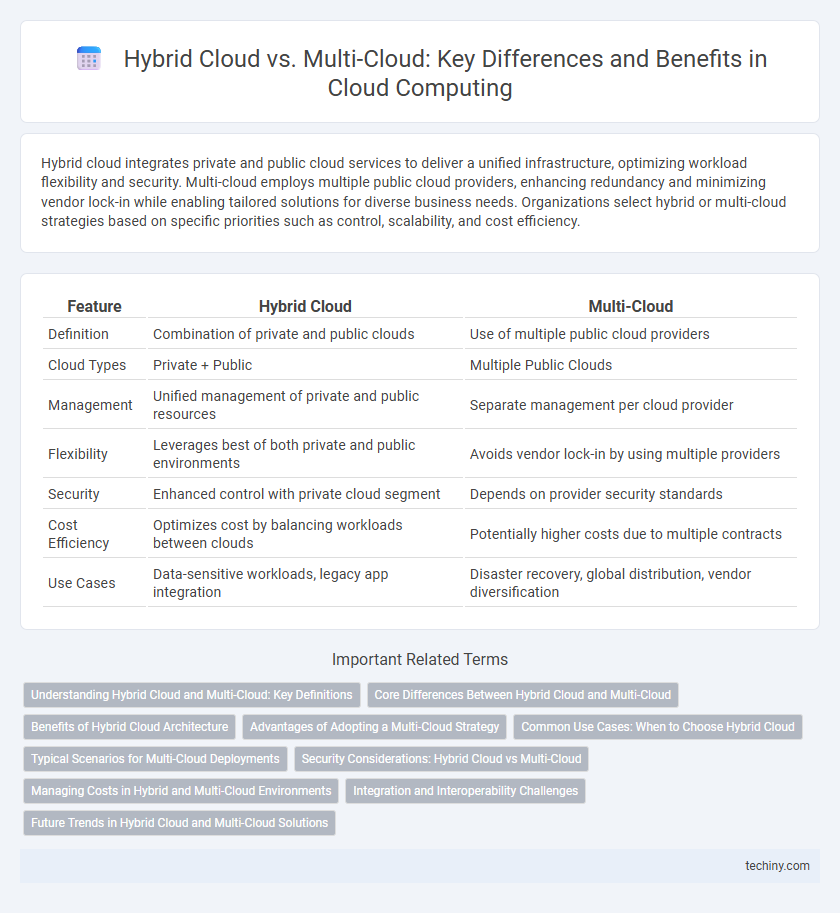Hybrid cloud integrates private and public cloud services to deliver a unified infrastructure, optimizing workload flexibility and security. Multi-cloud employs multiple public cloud providers, enhancing redundancy and minimizing vendor lock-in while enabling tailored solutions for diverse business needs. Organizations select hybrid or multi-cloud strategies based on specific priorities such as control, scalability, and cost efficiency.
Table of Comparison
| Feature | Hybrid Cloud | Multi-Cloud |
|---|---|---|
| Definition | Combination of private and public clouds | Use of multiple public cloud providers |
| Cloud Types | Private + Public | Multiple Public Clouds |
| Management | Unified management of private and public resources | Separate management per cloud provider |
| Flexibility | Leverages best of both private and public environments | Avoids vendor lock-in by using multiple providers |
| Security | Enhanced control with private cloud segment | Depends on provider security standards |
| Cost Efficiency | Optimizes cost by balancing workloads between clouds | Potentially higher costs due to multiple contracts |
| Use Cases | Data-sensitive workloads, legacy app integration | Disaster recovery, global distribution, vendor diversification |
Understanding Hybrid Cloud and Multi-Cloud: Key Definitions
Hybrid cloud combines private and public cloud infrastructures to create a unified, flexible environment that optimizes data security and workload distribution. Multi-cloud refers to the use of multiple public cloud services from different providers to enhance redundancy, avoid vendor lock-in, and leverage specialized capabilities from each platform. Understanding these key definitions helps organizations choose the right cloud strategy to meet scalability, compliance, and operational requirements.
Core Differences Between Hybrid Cloud and Multi-Cloud
Hybrid cloud integrates private and public cloud environments to enable seamless data and application portability, optimizing workload distribution and security. Multi-cloud involves using multiple public cloud services from different providers to avoid vendor lock-in, increase fault tolerance, and leverage diverse capabilities. The core difference lies in hybrid cloud's combination of private and public infrastructures versus multi-cloud's strategy of deploying multiple public clouds independently.
Benefits of Hybrid Cloud Architecture
Hybrid cloud architecture offers enhanced flexibility by seamlessly integrating private and public cloud environments, enabling organizations to optimize workloads based on security, compliance, and cost requirements. It provides improved scalability and disaster recovery capabilities through dynamic resource allocation across on-premises and third-party cloud infrastructures. Hybrid cloud solutions reduce vendor lock-in risks and improve data sovereignty controls, making them ideal for enterprises with diverse operational needs.
Advantages of Adopting a Multi-Cloud Strategy
A multi-cloud strategy enhances redundancy and minimizes the risk of vendor lock-in by distributing workloads across multiple cloud providers. It allows organizations to leverage the best services from each platform, optimizing performance, compliance, and cost-efficiency. Improved disaster recovery and increased flexibility in resource allocation further empower businesses to respond swiftly to changing demands.
Common Use Cases: When to Choose Hybrid Cloud
Hybrid cloud is ideal for businesses needing seamless integration of on-premises infrastructure with public cloud resources, enabling scalability while maintaining data control and compliance. It suits industries with strict security requirements, such as healthcare and finance, where sensitive data must remain in private environments but non-critical workloads leverage public cloud efficiency. Hybrid cloud also supports disaster recovery strategies by combining local backup capabilities with cloud-based redundancy, ensuring business continuity.
Typical Scenarios for Multi-Cloud Deployments
Multi-cloud deployments are typical in organizations seeking to optimize workload distribution by leveraging multiple public cloud providers such as AWS, Azure, and Google Cloud for enhanced redundancy, cost management, and compliance adherence. These scenarios often include disaster recovery, geographic data residency requirements, and the integration of best-of-breed services tailored to specific application needs. Enterprises use multi-cloud strategies to avoid vendor lock-in while ensuring flexibility and resilience across diverse infrastructure environments.
Security Considerations: Hybrid Cloud vs Multi-Cloud
Hybrid cloud environments integrate private and public cloud infrastructures, enhancing control over sensitive data through dedicated security protocols within private segments, while public clouds benefit from scalable, provider-managed protections. Multi-cloud strategies involve deploying services across multiple public cloud vendors, which can increase complexity in managing disparate security frameworks and policies, potentially leading to inconsistent threat responses. Ensuring robust encryption, unified identity and access management, and comprehensive compliance monitoring are critical to mitigating vulnerabilities inherent in both hybrid and multi-cloud architectures.
Managing Costs in Hybrid and Multi-Cloud Environments
Managing costs in hybrid and multi-cloud environments requires strategic resource allocation and continuous monitoring to avoid unnecessary expenses. Hybrid cloud combines private and public clouds, offering cost control through workload optimization and data residency, while multi-cloud leverages multiple public providers to prevent vendor lock-in but may increase complexity and overhead. Effective cost management tools and policies are essential to track usage, forecast spending, and optimize cloud expenditures across both hybrid and multi-cloud infrastructures.
Integration and Interoperability Challenges
Hybrid Cloud environments combine private and public cloud resources, presenting integration complexities due to differing architectures and security protocols. Multi-Cloud strategies involve multiple public cloud providers, creating interoperability challenges in managing diverse APIs and data formats. Ensuring seamless data flow and unified management across platforms requires advanced middleware and standardized communication protocols.
Future Trends in Hybrid Cloud and Multi-Cloud Solutions
Hybrid cloud and multi-cloud solutions are evolving with advancements in AI-driven automation, enhanced security frameworks, and seamless interoperability across diverse platforms. Enterprises increasingly adopt hybrid cloud to optimize workload distribution between private and public clouds, while multi-cloud strategies focus on avoiding vendor lock-in and maximizing service resilience. Future trends highlight improved unified management tools and integrated compliance protocols to support complex, scalable cloud ecosystems.
Hybrid Cloud vs Multi-Cloud Infographic

 techiny.com
techiny.com